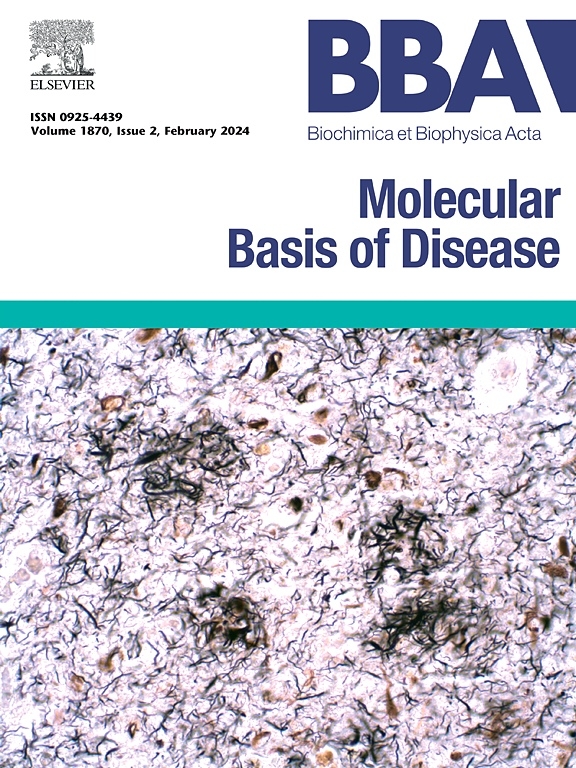通过人工智能和基于相互作用的建模揭示炎症性肠病中代谢物-微生物组的相互作用。
IF 4.2
2区 生物学
Q2 BIOCHEMISTRY & MOLECULAR BIOLOGY
Biochimica et biophysica acta. Molecular basis of disease
Pub Date : 2024-12-09
DOI:10.1016/j.bbadis.2024.167618
引用次数: 0
摘要
炎症性肠病(IBDs)是胃肠道和结肠的慢性炎症性疾病,影响全球约700万人。导致IBD的具体病理和病因机制的知识是有限的,然而免疫系统降低,抗生素的使用和保留饮食可能会引发症状。肠道微生物群的生态失调,以及由此导致的代谢组的不同组成,已被广泛地与这些危险因素和IBD联系起来。Fransoza等人对N = 220份粪便样本进行宏基因组测序和液相色谱质谱分析(LC-MS),为本研究提供了丰富的微生物属和代谢物数据。使用Wilcoxon检验鉴定差异丰度的微生物和代谢物,然后使用随机森林(RF)、梯度增强(XGBoost)和最小绝对收缩算子(LASSO)模型进行特征选择。然后使用人类微生物组计划2 (HMP2)数据集上的RF模型验证这些特征的性能,并使用微生物群落(MICOM)模型来预测和解释关键微生物与代谢物之间的相互作用。所有模型均发现黄酮类植物属和微生物在毛螺科和示波螺科中存在差异。这些微生物在IBD中通常影响的代谢途径是辅酶a生物合成、胆汁酸代谢和氨基酸的产生和降解。这项研究强调了IBD中独特的相互作用微生物组和代谢组谱,以及引起疾病病理的高度潜在途径。因此,它为未来研究IBD的新治疗靶点和非侵入性诊断工具铺平了道路。本文章由计算机程序翻译,如有差异,请以英文原文为准。
Unravelling metabolite-microbiome interactions in inflammatory bowel disease through AI and interaction-based modelling
Inflammatory Bowel Diseases (IBDs) are chronic inflammatory disorders of the gastrointestinal tract and colon affecting approximately 7 million individuals worldwide. The knowledge of specific pathology and aetiological mechanisms leading to IBD is limited, however a reduced immune system, antibiotic use and reserved diet may initiate symptoms. Dysbiosis of the gut microbiome, and consequently a varied composition of the metabolome, has been extensively linked to these risk factors and IBD. Metagenomic sequencing and liquid-chromatography mass spectrometry (LC-MS) of N = 220 fecal samples by Fransoza et al., provided abundance data on microbial genera and metabolites for use in this study. Identification of differentially abundant microbes and metabolites was performed using a Wilcoxon test, followed by feature selection of random forest (RF), gradient-boosting (XGBoost) and least absolute shrinkage operator (LASSO) models. The performance of these features was then validated using RF models on the Human Microbiome Project 2 (HMP2) dataset and a microbial community (MICOM) model was utilised to predict and interpret the interactions between key microbes and metabolites. The Flavronifractor genus and microbes of the families Lachnospiraceae and Oscillospiraceae were found differential by all models. Metabolic pathways commonly influenced by such microbes in IBD were CoA biosynthesis, bile acid metabolism and amino acid production and degradation.
This study highlights distinct interactive microbiome and metabolome profiles within IBD and the highly potential pathways causing disease pathology. It therefore paves way for future investigation into new therapeutic targets and non-invasive diagnostic tools for IBD.
求助全文
通过发布文献求助,成功后即可免费获取论文全文。
去求助
来源期刊
CiteScore
12.30
自引率
0.00%
发文量
218
审稿时长
32 days
期刊介绍:
BBA Molecular Basis of Disease addresses the biochemistry and molecular genetics of disease processes and models of human disease. This journal covers aspects of aging, cancer, metabolic-, neurological-, and immunological-based disease. Manuscripts focused on using animal models to elucidate biochemical and mechanistic insight in each of these conditions, are particularly encouraged. Manuscripts should emphasize the underlying mechanisms of disease pathways and provide novel contributions to the understanding and/or treatment of these disorders. Highly descriptive and method development submissions may be declined without full review. The submission of uninvited reviews to BBA - Molecular Basis of Disease is strongly discouraged, and any such uninvited review should be accompanied by a coverletter outlining the compelling reasons why the review should be considered.

 求助内容:
求助内容: 应助结果提醒方式:
应助结果提醒方式:


